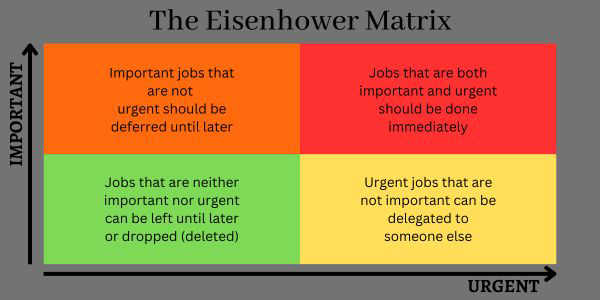Habits
Form, build and maintain habits. Use simply or sophisticatedly, with automation and customization.
Learn More →Time Tracking
Seamlessly track time on web and mobile with minimal friction. Use to complete Habits and Objectives.
Learn More →Measures
The data layer powering the wider ecosystem. Easily track manually or automatically with integrations.
Learn More →Objectives
Define success and then achieve it through Habits, Time Tracking, Measures and Integrations.
Learn More →
Have you ever met someone who seems to have it all together? They juggle work, family, exercise, hobbies, and fun, and it doesn't seem to slow them down for a second.
They do well at work, progressing in their career, yet their personal lives are full and fulfilling. You look at them and wonder how they do it.
Well, we're here to answer that question.
It's very simple, really—they are good at time management. Most successful people are.
If you often find yourself at the end of the day feeling like you haven't accomplished a fraction of what you'd hoped to, your problem probably isn't that you've got too much on your plate—it's that you're not managing your time properly.
In no way is this intended to belittle all that you do—you know you're a hard worker, and you deserve credit for that. However, time management is about being intentional, focused, decisive, and realistic about using your time to reach your goals with less stress and more confidence.
Manage time with ease!
Conjure can help you keep track of where your time is spent and if it's enough to get the outcomes you want.
What is time management?
Time management is the act of arranging your time in such a way that everything you need to do can get done. It involves careful planning to create an organized schedule that makes the most of your available time.
Whether you want to be better at making your project completion dates, finishing a scheduled task, or managing complex tasks, intentionally planning your time allows you to identify when you don't have enough time for some tasks, so you can prioritize and manage expectations with others.
Time management allows you to focus on tasks that most align to your goals and not over-allocate time to unaligned tasks.
People who don't manage their time often spend too much time on tasks that don't matter. Parkinson's law says that however much time you allocate for a task, the work will grow to use up all that time. So if you allocate extra time, the work will use up that time, whether necessary or not.
Manage your time with platforms like Conjure by planning and tracking time to spend on both personal and work projects, activities, habits, and goals. You will quickly be able to see if you're spending too little or too much time on them.
If you learn to manage your time successfully, there are many benefits you will discover, including greater confidence in your abilities, more control over your circumstances, and a better reputation.
People trust consistency, and will see that you are someone who does what they say they will do and when. This could lead to better relationships and more opportunities in your work life.
On a personal level, you will be happier and less stressed, allowing you to think more clearly, which in turn, leads back to better time management.
So how do you go about learning to manage your time better? We recommend you use the simplest time management technique—the 4 Ds of time management.
Here is a quick summary of the 4 Ds. Read on for a comprehensive guide to implementing them.
- Delete—remove tasks that are not essential.
- Delegate—hand over tasks that don't have to be done by you.
- Defer—delay tasks that are not time sensitive.
- Do—complete the things that must be done immediately.
What are the 4 Ds of time management?
The 4 Ds of time management are a time management system based on the Eisenhower Matrix (or Eisenhower Box) and the Inbox Zero method.

Although the Inbox Zero method is linked purely to how you manage your emails, it is a very good way to save time and become more efficient in the office.
The 4 Ds were first thought up by Daniel Johnson in the late 1980s and were mentioned in the book, Career Comeback: Taking Charge of Your Career by Jacquie Wise (1991).
This time management method is very simple to implement. It can be used by anyone, from students, parents, and freelancers to project managers.
This simple method allows you to prioritize your tasks and projects based on their level of urgency so that the most important tasks are completed first, and the least important are deferred to a later date.
This method is used by beginners and expert time managers alike—its simplicity is a draw for all who wish to manage their time better. It offers a way to stay focused while working through tasks in a way that will ensure the desired outcome.
Your first step in any situation that needs to be time managed is to figure out exactly what you need to do, followed by which category each task fits into.
1. Delete

Gif by fuzzyghost via Giphy
It's easy to get caught up in the stress of all the little things you think you have to do. Sometimes, so much so that you don't even recognize the unimportance of some of the tasks.
Once you have made a list of all the tasks you think you need to do, have a good look through it and decide if each and every task does actually need to be done. The most efficient strategies of time management always involve the removal of unimportant and unnecessary tasks.
Here are some questions to ask yourself to help you determine which tasks can be deleted:
- Has someone asked you to attend a meeting that doesn't actually require your presence?
- Are there things on your to-do list that won't actually enhance your life or your job if you do them?
- By saying yes to a task, what are you saying no to?
- Does the task at hand align with your goals?
Remove these from your list and concentrate on what really must be done.
Learning to say no is a very important aspect of this action. If you tend to agree to do every task everyone asks you to do, you will never learn to properly manage your time, and you will never be able to delete non-essential tasks from your list. Some kind ways of saying no include things like, “I’d love to, but I can’t,” or I don’t have time now, but ask again in a few weeks.”
Avoid attending meetings that are unimportant and a waste of your valuable time. Saying no to requests that don't fit in with your schedule and aren't necessary for your professional development is an essential skill that will help you regain time control.
According to Derek Sivers, everything you do should fall into one of two categories — Hell, yeah, or no. Wherever possible, avoid doing things you don’t care about. If you can’t delete them, try delegating them to someone else.
2. Delegate
Check your to-do list for items that can be handed over to someone else, saving your time for more important things.
Learning to delegate can be difficult for some people. If you like to be in control of everything, it might be tough to start handing off tasks, especially if you believe you will do a better job than the person you are giving the task to. However, delegating is the key to becoming efficient, no matter the situation.
Here are some questions you can ask yourself to help you filter out tasks that should be delegated:
- Is the task within my area of expertise or someone else's?
- Does delegating the task align with the roles and responsibilities of others on my team?
- Will delegating the task free up my time to focus on more important or high-priority tasks?
Whether you're a stay-at-home mom, a member of a work team, or the CEO of a company, you should consider delegating tasks to become as efficient as you can.
This could mean asking your kids to wash the dishes or your spouse to cook the dinner; it could mean asking a teammate to complete one of your tasks; or it could mean asking a trusted manager to make some decisions for your company.
Time is your most precious resource and you need to maximize your available time. Even partially delegating a task and having someone help with it, reducing the time it requires from you, can make a big difference.
Delegating a task does not mean handing it over and forgetting about it. It's always best to keep an eye on the person you have delegated the task to, to ensure it is done timeously and correctly.
3. Defer
Deferring a task refers to the act of putting off till tomorrow the tasks you cannot (and don't have to) do today. Look carefully at your to-do list and identify those tasks that, although they seem urgent, actually aren't. We call these fake urgent tasks.
Separate fake urgent tasks from those that are really urgent, and set a time to deal with them later. You can also defer or postpone tasks that have later deadlines than what you are working on right away. This time management process is simply the act of prioritizing each particular task by when it must be completed.
Here are some questions that can help you determine whether to defer a task:
- Is the task time-sensitive or does it have a strict deadline that cannot be compromised?
- Are there higher-priority tasks that require immediate attention and should take precedence over this task?
- Will deferring the task have any negative consequences or impact on other projects, stakeholders, or team members?
The danger of deferring tasks is that it is easy to fall into the trap of procrastination. Make sure you add your deferred tasks to your task list for the day they must be completed, and don't put them off again.
4. Do
Good planning can only take you so far. Now that you have deleted the unnecessary tasks, delegated those that could be passed on, and deferred those with longer deadlines, it's time to get down to the doing.
Certain tasks cannot be put off or handed over and must be dealt with by you right away. This is where successful time managers will avoid distraction, remain focused, and get the job done now, rather than later.
Your to-do lists should be pretty well organized by now, with only the most urgent and necessary tasks left for today. Start doing those tasks immediately.
Again, there is a danger of procrastination here. When you're done filtering tasks and deciding how to simplify your existing to do list into one that is more manageable, don't get stuck doing unimportant tasks like checking your email or other insignificant things.
Being willing to set a time-limit on certain tasks, so you don't spend too much time on them, is a very helpful tactic. "Done" is better than "perfect" and each task can have a "diminishing point of returns".
Video: The 4 D's of Time Management - The Simple & Most Effective solution by We Grow People
Frequently asked questions
Who invented the 4 Ds of time management?
The 4 Ds of time management were initially outlined by Daniel Johnson in 1986 and later mentioned in Jacquie Wise's 1991 book, Career Comeback: Taking Charge of Your Career, which gave credit to Daniel Johnson.
However, the time management method was later popularized by Jack Canfield of Chicken Soup for the Soul fame, Mark Victor Hansen, and Les Hewitt in their 2001 book, The Power of Focus.
Are there any cons to the 4 Ds of time management?
There are some limitations to this time management method. It is a simple and easy-to-implement strategy, but its simplicity does mean that it may not work in very complex situations.
It also does not include any sub-categories, but this can be remedied by the user. For example, you could have date or deadline categories within the defer aspect.
Like any time management technique, the 4 Ds will only work if you are willing to make changes to your daily routine and habits, and it can be difficult to create a constant flow that keeps you focused and on task.
The other issue with this method is human error—if you fail to categorize all the components correctly, your time management attempt will fail, and this could negatively affect your job and your life.
Conclusion
The 4 Ds of time management—delete, delegate, defer, and do—are a simple method of time management that can help you to organize your time so that you can meet your due dates and feel more in control of your life.
However, for this method to work, you will need to learn to filter requests, like saying no to non-vital meetings, and you will have to be able to determine the importance of each individual task so you can sort it into the correct category.
You can use Conjure to track the time you spend on all your various projects and activities to make sure you’re putting in the required time on each one. You can also link your tracked time to habits and goals to ensure consistency.
Time management is an essential skill, and you will thank yourself for learning it. It takes practice and, ironically, time, to get good at time management, so start implementing the 4 Ds as soon as possible!
Sign up here for Conjure, the habit, time, and goal tracking platform that will help you manage your time, change your habits, and become the person you want to be.

